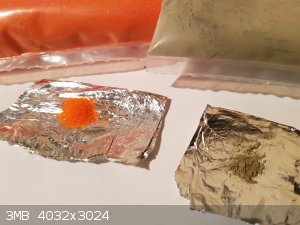Prepic
Harmless

Posts: 31
Registered: 23-4-2019
Member Is Offline
|
|
Pottery grade materials purity (NiO and K2Cr2O7)
Hey all,
So recently I've acquired some pottery grade Nickel (II) oxide and Potassium dichromate and been wanting to use them in some upcoming chemistry
experiments. My concern is the purity of the pottery grade materials.
I've tried to do some research on both and it seems that the potassium dichromate is made industrially from mixing sodium dichromate and potassium
chloride to yield potassium dichromate. Alternatively an acid and potassium chromate route . I suspect the purity here to be good enough especially
since I doubt chlorides / chromates will be an issue for my use.
For the nickel oxide, I am not sure about what process would have been used but I honestly would imagine some simple precipitation of nickel
hydroxide / carbonate followed by pyrolysis leading to a quite impure product. I would like to make urushibara catalysts with this nickel oxide.
So basically, can anyone comment on my thinking here and perhaps suggest ways I can clean up my nickel oxide to make it extra pure? Also, if anyone
has used pottery grade materials as is and reckons I should not worry I'd also find that useful.
|
|
|
woelen
Super Administrator
        
Posts: 7976
Registered: 20-8-2005
Location: Netherlands
Member Is Offline
Mood: interested
|
|
The nickel oxide most likely is not NiO, but Ni2O3. If it is black, then it is Ni2O3, if it is green, then it is NiO.
K2Cr2O7 has a very bright orange color. If it is dull-orange or brown-orange, then it is not very pure. K2Cr2O7, however, can be purified very easily.
Dissolve it in as little as possible of boiling hot distilled water. This solution will be dark orange, nearly red. If the solution is turbid, filter
it while boiling hot. Let the clear solution cool down slowly (important to have a slow cool down). Crystals will settle. Once the solution is at room
temperature, put it in a freezer and allow it to cool down further to a little under 0 C (but do not allow it to freeze). You will have a lot of
crystal mass. Decant as much of the ice cold liquid and keep the crystal mass.
Put the crystal mass on a coffee filter, with a lot of paper tissue under it, so that the liquid is sucked in the paper tissue. Once most of the
liquid is absorbed by paper tissue, take a lot of fresh paper tissue and gently press the crystal mass between the coffee filter with paper tissue
around it. Avoid direct contact between the paper tissue and the crystals. In this way you get fairly dry K2Cr2O7 of very good purity. Next, spread
the crystals on a glass plate and allow to dry in contact with air, free of dust.
The liquid, which you decanted, contains 10% or so of your K2Cr2O7, with nearly all of the impurities. It is not worth the hassle to try to get the
last bit of K2Cr2O7 from that. If you really insist on retrieving that, you could boil down this liquid, and try to crystallize some K2Cr2O7 from it,
but do not mix that K2Cr2O7 with your first big crop. It will be quite impure. I would not put the effort in it, I simply would destroy it with some
acid and sulfite to convert it to chromium(III) and discard the solution.
|
|
|
unionised
International Hazard
    
Posts: 5102
Registered: 1-11-2003
Location: UK
Member Is Offline
Mood: No Mood
|
|
If you want to purify the nickel oxide the first step is to get it into solution.
That could take some doing.
If it's freshly precipitated it will dissolve easily enough but if it has been calcined than you are looking at a slow process with hot acid.
My best guess is that the dominant impurities will be copper chromium, and/ or iron.
Once it's in solution you can precipitate copper as the iodide.
Adding a little oxidising agent - H2O2 or HNO3 will convert any Fe(II) to Fe(III) and adding enough base to precipitate a little of the material will
take out Fe and Cr first.
|
|
|
CharlieA
National Hazard
   
Posts: 645
Registered: 11-8-2015
Location: Missouri, USA
Member Is Offline
Mood: No Mood
|
|
If you know the manufacturer(s) of these compounds, perhaps you can get the MSDS/SDS for them to get some idea of purity.
|
|
|
Prepic
Harmless

Posts: 31
Registered: 23-4-2019
Member Is Offline
|
|
Thanks for the great replies - I've attached an image for those interested.
I think i'll purify just a small amount of the dichromate as Woelen suggest since it seems really easy to do and from there i'll see if its worth to
proceed with purifying larger quantities.
The NiO is really struggling to dissolve in conc. HCl so I've started to add heat (Dark, strong green solution formed). That said, instead of
precipitating iron and chromium impurities with a base as Unionised suggested, could I instead leach it out with cold / dilute HCl or wouldn't that be
a smart / effective way of doing it?
Thanks again.
(edit: spelling)

[Edited on 5-6-2019 by Prepic]
|
|
|